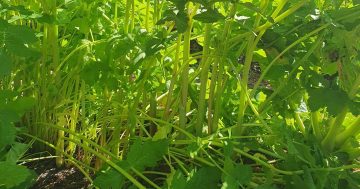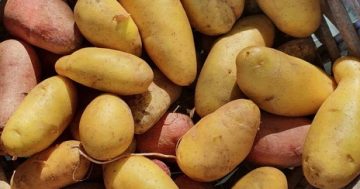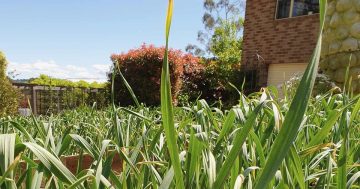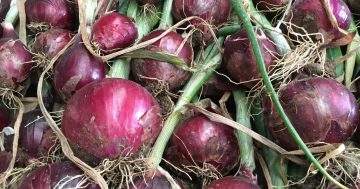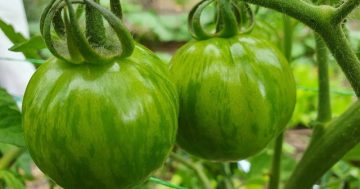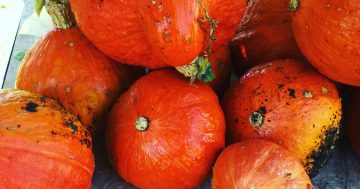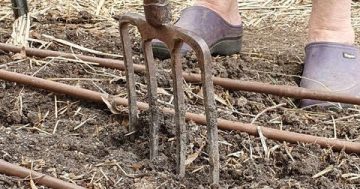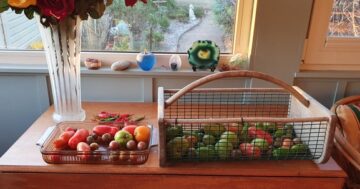
Plant your summer crops now for a bountiful harvest. Photo: Wynlan House.
This month, food growers living in the coldest part of our cool/cold climate zone are getting ready to plant out summer vegetable seedlings, including sweet corn, short-season melons, sunflowers, tomatoes, eggplants, potatoes, cucumber, capsicum and beans.
Given that some parts of our region had a frost in the last week of October, many gardeners in Canberra, Yass, Braidwood and Goulburn wait until early to mid-November to put their seedlings in the ground.
Patience is a quality possessed by many of us gardeners, but it is greatly tested in the spring months when we are tempted to plant these frost-tender summer vegetables early. Some are rewarded for their boldness, but others punished when that last frost hits! This is where understanding your area’s microclimate and trusting your experience and knowledge pays you back in delicious tomatoes, potatoes, capsicum and chilli when you expect them.
Capsicum (or is it peppers?) is a much-desired vegetable in the summer garden, but what is the difference? The main difference is the country you come from.
In Australia, New Zealand, India and Singapore, these wonderful mild, crispy summer fruits are generally known as capsicum. In North America, South Africa, the United Kingdom, Ireland and Malaysia, they are referred to as peppers or sweet peppers.
In Australia, we tend to refer to the blocky, bell-shaped fruits of this family as capsicums and the long, slimmer fruits as peppers. Either way, there is nothing better than a bowl of chopped tomato, capsicum (sweet pepper) and cucumber to accompany a summer BBQ.
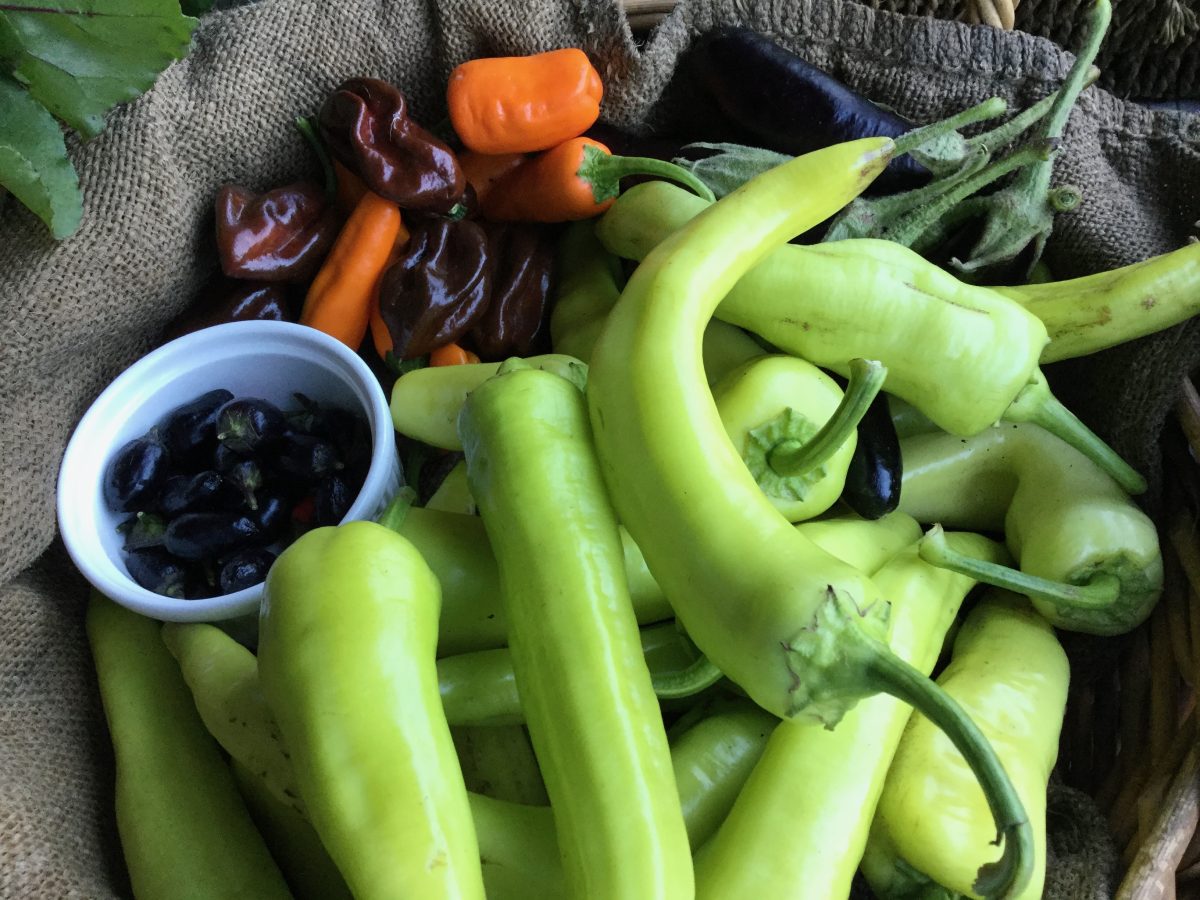
Peppers thrive in a warm, protected spot in full sun away from the drying summer wind. Photo: Wynlan House.
Capsicum is another member of the Solanaceae family, which, along with tomatoes, eggplant and potatoes, require similar growing conditions. They thrive in a warm, protected spot in full sun away from the drying summer wind. They prefer mild humidity and light, well-aerated soil rich in compost, well-composted animal manure or blood & bone, a complete pelleted fertiliser, a sprinkling of powdered kelp, potash and a teaspoon of Epsom salts around their stem when close to flowering. While there is little scientific evidence in favour of Epsom salts, there is plenty of generational gardening advice that says it helps!
There are many varieties available now as seedlings to enjoy, ranging from the typical capsicum to mild sweet peppers and hot chili peppers and everything in between. Our shorter growing season (when compared to warm temperate zones) often means that unless using a hot house, growing the delicious bell capsicum to full maturity might be difficult. Instead, opt for the Banana pepper which, because of its long thinner shape, will reach maturity sooner.
Another similar type is the bullhorn pepper. The next group of peppers to plant is the mild grilling/drying chilli peppers such as Anaheim, Poblano, Pimento, Shishito and Pepperoncini (‘Friggitello’). Of these, Shishito and Poblano should be the most available.
The next group to plant are those that add a little heat (not too much) and are fabulous for making chilli sauces and jams that most people can eat easily, and that add a display of colour and shape to stir fries and curries. Jalapeño, the hotter Serrano, Cayenne (hotter still), and the common ‘Long Red or Long Green’ chilli peppers grow well in our region’s summer. Many varieties covered in this category are easily purchased from seedling sellers now.
The last group from which to grow are the very hot varieties. If you like very hot food then this group will delight. The habanero, Thai Bird’s eye, Trinidad Scorpion, and a few Australian-bred varieties from our north: Australian Atomic (top-end Darwin) and Australian Broome from Western Australia. These two won’t be readily available now, but watch out for them in the future.
It is now too late to propagate chilli from seed. Plant the seedlings between 40 cm to 60 cm apart to allow for their bushy growth. In late January and February, you should see your garden ablaze with red and green. If a warm autumn is predicted, leave some on the bush to redden and enjoy their spectacular red colours.

Beans like the soil moist, add compost and a little blood and bone plus mulch if the summer is set to be hot. Photo: Wynlan House.
Beans are another good summer vegetable to start now, either as seeds or seedlings. They are nitrogen-fixing like all legumes, working with soil bacteria to move nitrogen from the air to the soil. Bean types include dwarf, bush and climbing, stringed and stringless, and, of course, the coloured kinds mostly in purple and yellow.
Climbing beans need a trellis or tepee or to be grown with corn so they can climb the stalks. There are a number of good, reliable varieties that do well in our region: Scarlet runner, a climbing bean and a so-called seven-year bean although this is not the case in cool/cold climate zones) is an outstanding flat, meaty bean. Blue Lake is an heirloom and still very popular climbing bean; Cherokee Wax, a commonly grown and hardy, yellow bush butter bean; Lazy Wife, a climber and very popular; and Provider, a bush bean that germinates in cooler soil than other varieties.
Here at Wynlen House, we plant both bush and climbing varieties, as diversity will increase the chances of still getting a crop in spite of any adverse and damaging weather events we may experience this season. Beans like the soil moist, add compost and a little blood and bone, plus mulch if the summer is set to be hot.
Other seedlings to plant out this month, especially in the cold climate part of our region, include celery, celeriac, beetroot, Asian greens, bulbing fennel, all types of peas, all the brassica’s broccolini, broccoli, cauliflower (this will be the last month to plant cauli in Canberra), cabbage, kohl rabi, carrots, parsnips, radishes, Japanese turnips, and daikon.
So many wonderful things to grow at this time of year! Happy summer planting!
Bronwyn Richards and Helen Lynch run Wynlen House Artisan Village Farm and Learning Centre, a small village organic market garden in Braidwood, NSW. Since 2006 they have grown and sold fresh vegetables, eggs, preserves and garlic, and teach others to do the same.












